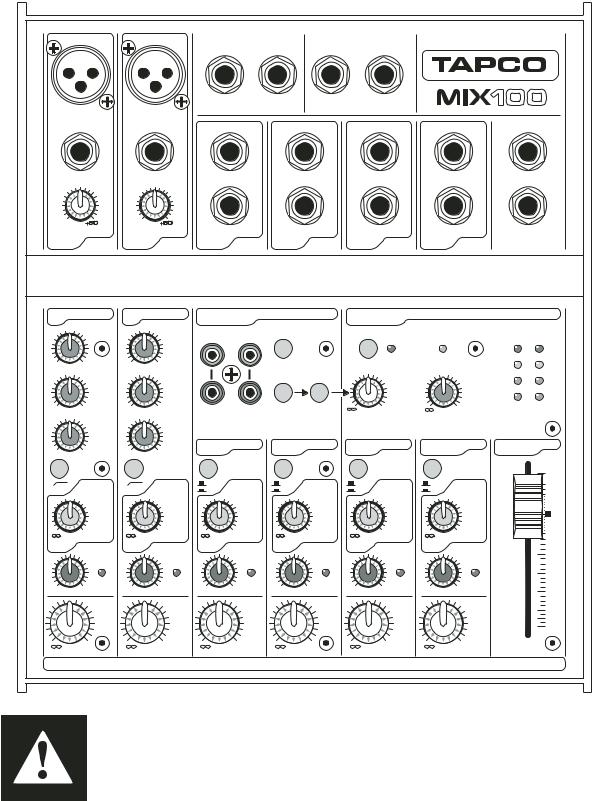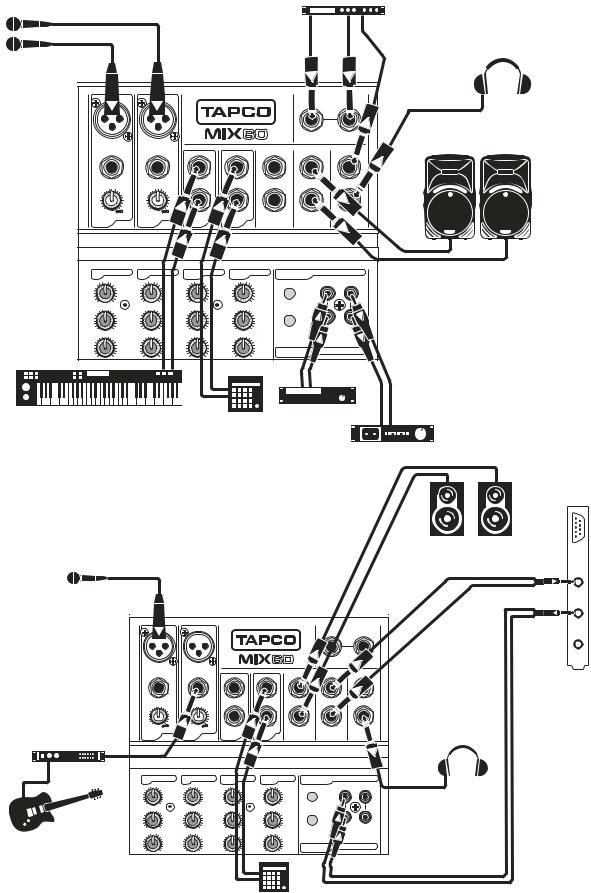Tapco MIX-60 Owners manual


CAUTION AVIS
RISK OF ELECTRIC SHOCK
DO NOT OPEN
RISQUE DE CHOC ELECTRIQUE
NE PAS OUVRIR
CAUTION: TO REDUCE THE RISK OF ELECTRIC SHOCK
DO NOT REMOVE COVER (OR BACK)
NO USER-SERVICEABLE PARTS INSIDE
REFER SERVICING TO QUALIFIED PERSONNEL
ATTENTION: POUR EVITER LES RISQUES DE CHOC
ELECTRIQUE, NE PAS ENLEVER LE COUVERCLE. AUCUN
ENTRETIEN DE PIECES INTERIEURES PAR L'USAGER. CONFIER
L'ENTRETIEN AU PERSONNEL QUALIFIE.
AVIS: POUR EVITER LES RISQUES D'INCENDIE OU
D'ELECTROCUTION, N'EXPOSEZ PAS CET ARTICLE
A LA PLUIE OU A L'HUMIDITE
The lightning flash with arrowhead symbol within an equilateral triangle is intended to alert the user to the presence of uninsulated “dangerous voltage” within the product’s enclosure that may be
of sufficient magnitude to constitute a risk of electric shock to persons. Le symbole éclair avec point de flèche à l'intérieur d'un triangle
équilatéral est utilisé pour alerter l'utilisateur de la présence à l'intérieur du coffret de “voltage dangereux” non isolé d'ampleur suffisante pour constituer un risque d'éléctrocution.
The exclamation point within an equilateral triangle is intended to alert the user of the presence of important operating and maintenance (servicing) instructions in the literature accompanying the appliance.
Le point d'exclamation à l'intérieur d'un triangle équilatéral est employé pour alerter les utilisateurs de la présence d'instructions importantes pour le fonctionnement et l'entretien (service) dans le livret d'instruction accompagnant l'appareil.
SAFETY INSTRUCTIONS
1.Read these instructions.
2.Keep these instructions.
3.Heed all warnings.
4.Follow all instructions.
5.Do not use this apparatus near water.
6.Clean only with a dry cloth.
7.Do not block any ventilation openings. Install in accordance with the manufacturer’s instructions.
8.Do not install near any heat sources such as radiators, heat registers, stoves, or other apparatus (including amplifiers) that produce heat.
9.Do not defeat the safety purpose of the polarized or grounding-type plug. A polarized plug has two blades with one wider than the other. A grounding-type plug has two blades and a third grounding prong. The wide blade or the thrid prong are provided for your safety. If the provided plug does not fit into your outlet, consult an electrician for replacement of the obsolete outlet.
10.Protect the power cord from being walked on or pinched particularly at plugs, convenience receptacles, and the point where they exit from the apparatus.
11.Only use attachments/accessories specified by the manufacturer.
12.Use only with a cart, stand, tripod, bracket, or table specified by the manufacturer, or sold with the apparatus. When a cart is used, use caution when moving the cart/apparatus combination to avoid injury from tip-over.
PORTABLE CART WARNING
Carts and stands - The Component should be used only with a cart or stand that is recommended by the manufacturer.
A Component and cart combination should be moved with care. Quick stops, excessive force, and uneven surfaces may cause the Component and cart combination to overturn.
13.Unplug this apparatus during lightning storms or when unused for long periods of time.
14.Refer all servicing to qualified service personnel. Servicing is required when the apparatus has been damaged in any way, such as when the power-supply cord or plug has been damaged, liquid has been spilled or objects have fallen into the apparatus, the apparatus has been exposed to rain or moisture, does not operate normally, or has been dropped.
15.This apparatus shall not be exposed to dripping or splashing, and no object filled with liquids, such as vases, shall be placed on the apparatus.
16.This apparatus has been designed with Class-I construction and must be connected to a mains socket outlet with a protective earthing connection (the third grounding prong).
17.This apparatus has been equipped with a single-pole rockerstyle AC mains power switch. This switch is located on the front panel and should remain readily accessible to the user.
18.This apparatus does not exceed the Class A/Class B (whichever is applicable) limits for radio noise
emissions from digital apparatus as set out in the radio interference regulations of the Canadian Department of Communications.
ATTENTION —Le présent appareil numérique n’émet pas de bruits radioélectriques dépassant las limites applicables aux appareils numériques de class A/de class B (selon le cas) prescrites dans le règlement sur le brouillage radioélectrique édicté par les ministere des communications du Canada.
18.Exposure to extremely high noise levels may cause permanent hearing loss. Individuals vary considerably in susceptibility to noise-induced hearing loss, but nearly everyone will lose some hearing if exposed to su ciently intense noise for a period of time. The U.S. Government’s Occupational Safety and Health Administration (OSHA) has specified the permissible noise level exposures shown in the following chart.
According to OSHA, any exposure in excess of these permissible limits could result in some hearing loss. To ensure against potentially dangerous exposure to high sound pressure levels, it is recommended that all persons exposed to equipment capable of producing high sound pressure levels use hearing protectors while the equipment is in operation. Ear plugs or protectors in the ear canals or over the ears must be worn when operating the equipment in order to prevent permanent hearing loss if exposure is in excess of the limits set forth here.
Duration Per Day |
Sound Level dBA, |
Typical |
In Hours |
Slow Response |
Example |
890 Packed garage concert
692
495 VW Bus Peace Train
397
2100 Cranked psychedelic tunes
1.5102
1105 High speed chase on C.H.I.P.s
0.5 |
110 |
|
0.25 or less |
115 |
Loudest parts at a Heavy Metal |
WARNING — To reduce the risk of fire or electric shock, do not expose this appliance to rain or moisture.
2

CONTENTS |
|
SAFETY INSTRUCTIONS................................................. |
2 |
GETTING STARTED ............................................................ |
4 |
INTRODUCTION.................................................................. |
6 |
HOOKUP DIAGRAMS........................................................ |
7 |
MIX SERIES FEATURES .................................................... |
8 |
CHANNEL INPUTS....................................................... |
8 |
CHANNEL CONTROLS............................................. |
8 |
AUX RETURN SECTION.......................................... |
10 |
TAPE SECTION............................................................ |
10 |
MAIN SECTION........................................................... |
12 |
OUTPUT CONNECTIONS .................................... |
13 |
REAR PANEL FEATURES ....................................... |
14 |
APPENDIX A: SERVICE INFORMATION .............. |
15 |
APPENDIX B: CONNECTIONS ................................. |
16 |
APPENDIX C: MIX SERIES SPECIFICATIONS .. |
17 |
Block Diagram Mix.50............................................... |
19 |
Block Diagram Mix.60............................................... |
20 |
Block Diagram Mix.100............................................ |
21 |
Block Diagram Mix.120............................................ |
22 |
TAPCO LIMITED WARRANTY ................................... |
23 |
Don’t forget to visit our website at www.tapcogear.com for more information about this and other TAPCO products.
What me, read a manual?
Before you begin, please make sure you read the Safety Instructions on page 2 and Getting Started on page 4.
Your new TAPCO® MIX Series mixer is designed to set up quickly and operate easily. We know it’s often seen as a sign of weakness to read a manual, along with asking for directions when lost, but maybe you can read the rest when nobody is looking.
It is important to keep your receipt in a safe place, and not a bad idea to write your product information here for future reference (i.e., insurance claims, tech support, return authorization, etc.).
Product Serial #:
Purchased at:
Date of purchase:
Part No. SW0208 Rev. A 5/05
©2005 LOUD Technologies Inc. All Rights Reserved.
3

GETTING STARTED
The following steps will help you set up your mixer, and get the levels and adjustments just right.
ZERO THE CONTROLS:
1.Leave the POWER cord disconnected from the MIX Series mixer.
2.Turn down the channel strip GAIN, AUX SEND, and LEVEL controls.
3.Center the channel strip EQ and PAN/BAL controls.
4.Turn down the MASTER AUX SEND and CTRL ROOM/PHONES controls.
5.Leave all switches out (up).
6.Turn down the MAIN MIX control.
CONNECTIONS:
1.Connect your speakers to your amplifier’s outputs (unless, of course, you have powered speakers).
3.Using TR or TRS cables, make connections from your mixer’s MAIN OUT to your amplification system’s line inputs.
4.Connect your microphones and instruments to the mixer: Connect microphones to the mono channel MIC INPUT jacks. (For condenser microphones, engage the PHANTOM POWER switch — not available on the Mix.50.) Connect line-level signal sources to the LINE input jacks. Note: Normally, you would plug in only one microphone or one instrument into each mono channel.
5.Zero the controls, as described above.
6.Connect the power cord supplied with your mixer to the POWER connection on the back and plug it into an AC outlet properly configured for your model.
7.Plug all other sound system components into suitable AC outlets, properly grounded and capable of delivering adequate current.
8.Turn all the power switches on, leaving the speaker’s amplifier’s switch for last.
Note: There is no power switch on the MIX Series mixers. They are powered up as soon as they are plugged in to an AC outlet.
9.Turn up the MAIN MIX control to the 9 o’clock position (for the Mix.50 and Mix.60) or to the –10 mark (for the Mix.100 and Mix.120), for now. We’ll crank it up later on.
10.Now you are ready to set the levels.
SET THE LEVELS (Mic/Line Channels):
1.Choose one of the microphones or instruments you connected to the mono MIC or LINE input. Make some noise. If it’s a microphone, sing at your normal singing volume. If it’s an instrument, play it at its normal output level.
2.While making noise, turn up that channel’s GAIN until the PEAK LED (next to the PAN control) starts blinking.
3.Raise that channel’s LEVEL to unity gain (U label). You should be hearing your noise now.
4.If necessary, apply channel EQ changes. (You may need to compensate for level changes afterward with the channel LEVEL control.)
5.Repeat steps 1 through 4 for the other Mic/Line channel(s).
6.Stop making noise. Everyone: start making music.
7.Now turn up the MAIN MIX control to a comfortable listening level.
SET THE LEVELS (Stereo Line Channels):
1.Make some noise with the mono or stereo instrument connected to the LINE IN jacks on a stereo line-input channel.
2.Adjust the line-input signal level at the source until the PEAK LED (next to the PAN control) starts blinking.
Note: The Mix.50 does not have PEAK LEDs on its two stereo channels. In that case, set the input signal to its normal operating level, but listen
for any signs of distortion. If the signal sounds distorted (and not on purpose!), then turn down the input signal at the source.
3.Raise that channel’s LEVEL control until it is approximately equal in volume to the microphones or instruments connected to channels 1 and 2.
4.If necessary, apply channel EQ changes. (You may need to compensate for level changes afterward with the channel LEVEL control.)
5.Repeat steps 1 through 4 for the remaining stereo channels.
4

|
|
|
|
|
|
|
L |
R |
L |
|
R |
|
|
|
|
MIC |
MIC |
|
MAIN OUT |
CTRL RM OUT |
|
|
|
|
|||||||
|
|
|
|
|
|
|
|
|
|
||||||
INPUT |
INPUT |
|
|
|
|
|
|
|
|
|
|
||||
BAL/UNBAL |
BAL/UNBAL |
MONO |
MONO |
MONO |
MONO |
|
|
||||||||
|
|
|
|
|
|
|
L |
|
L |
|
L |
|
L |
|
|
|
|
LINE |
|
|
LINE |
BAL/UNBAL |
BAL/UNBAL |
BAL/UNBAL |
BAL/UNBAL |
AUX SEND |
|||||
|
|
|
|
|
|
||||||||||
|
|
|
|
|
|
|
|
||||||||
|
|
|
|
|
|
|
R |
|
R |
|
R |
|
R |
|
|
0 |
|
|
0 |
|
|
|
|
|
|
|
|
|
|
|
|
1 |
GAIN |
|
GAIN |
|
LINE |
|
LINE |
|
LINE |
|
LINE |
PHONES |
|||
|
|
2 |
|
|
3/4 |
|
5/6 |
|
7/8 |
|
9/10 |
|
|
||
1 |
|
EQ |
2 |
|
EQ |
TAPE |
|
|
MAIN |
|
|
|
|
||
U |
|
U |
|
|
|
|
|
|
|
|
|
|
|
||
|
|
|
|
|
|
|
|
|
|
|
|
|
|
||
|
|
|
|
|
|
|
L |
TAPE |
|
|
|
|
|
|
|
|
|
|
|
|
|
|
|
TO |
|
|
|
|
OL |
|
|
|
|
|
|
|
|
|
|
MIX |
|
|
POWER |
|
|||
|
|
|
|
|
|
|
|
|
|
|
|
||||
|
|
|
|
|
|
|
|
|
|
PHANTOM 48V |
|
|
|||
-15 |
+15 HIGH |
-15 |
+15 HIGH |
|
|
|
|
|
|
+6 |
|
||||
|
|
|
|
|
|
U |
|
|
|||||||
U |
|
12kHz |
U |
|
12kHz |
|
|
|
|
|
|
|
|
|
|
|
|
|
|
|
|
|
|
|
|
|
|
|
|
0 |
|
|
|
|
|
|
|
|
R |
|
|
|
|
|
|
-20 |
|
-15 |
+15 |
MID |
-15 |
+15 |
MID |
|
TAPE TO |
FX TO |
|
MAX |
|
+15 |
L |
R |
|
IN |
OUT |
CTRL RM / |
CTRL |
|
|
||||||||||
CTRL ROOM/ |
|
||||||||||||||
U |
|
2.5kHz |
U |
|
2.5kHz |
CD/TAPE |
PHONES |
ROOM |
AUX |
|
|
||||
|
|
|
|
|
|
|
|
PHONES |
SEND |
|
|
||||
|
|
|
|
|
|
INPUT/OUTPUT |
|
|
|
|
|||||
|
|
|
|
|
|
|
|
|
|
|
|
||||
|
|
|
|
|
|
3/4 |
5/6 |
|
7/8 |
9/10 |
MAIN |
|
|||
-15 |
+15 |
LOW |
-15 |
+15 |
LOW |
|
MIX |
|
|||||||
|
|
80Hz |
|
|
80Hz |
|
|
|
|
|
|
|
|
|
|
|
|
|
|
|
|
|
|
|
|
|
|
|
|
|
|
|
|
|
|
|
|
|
|
|
|
|
|
|
|
|
10 |
75Hz |
AUX |
75Hz |
AUX |
+4 |
AUX |
+4 |
AUX |
+4 |
AUX |
+4 |
AUX |
|
|
||
-10 |
-10 |
-10 |
-10 |
|
|
||||||||||
U |
SEND |
U |
SEND |
U |
SEND |
U |
SEND |
U |
SEND |
U |
SEND |
|
5 |
||
|
|
||||||||||||||
|
|
|
|
|
|
|
|
|
|
|
|
|
|
|
U |
|
+15 |
|
|
+15 |
|
|
+15 |
+15 |
|
+15 |
|
+15 |
|
5 |
|
|
PAN |
|
PAN |
|
BAL |
|
BAL |
|
BAL |
|
BAL |
|
10 |
||
|
|
|
|
|
|
|
|
|
|
|
|
|
|
|
|
|
|
|
|
|
|
|
|
|
|
|
|
|
|
|
20 |
|
|
PEAK |
|
|
PEAK |
|
PEAK |
|
PEAK |
|
PEAK |
|
PEAK |
|
|
L |
R |
|
L |
R |
L |
R |
L |
R |
L |
R |
L |
R |
|
30 |
|
U |
LEVEL |
U |
LEVEL |
U |
LEVEL |
U |
LEVEL |
U |
LEVEL |
U |
LEVEL |
|
|
||
|
|
|
|
|
|
|
|
|
|
|
|
|
|
|
40 |
|
|
|
|
|
|
|
|
|
|
|
|
|
|
|
50 |
|
|
|
|
|
|
|
|
|
|
|
|
|
|
|
60 |
|
|
|
|
|
|
|
|
|
|
|
|
|
|
|
OO |
|
+15 |
|
+15 |
|
+15 |
+15 |
|
+15 |
|
+15 |
|
|
|||
A FEW PRECAUTIONS:
•Never listen to loud music for prolonged periods. Please see the Safety Instructions on page 2 for information on hearing protection.
•Never plug amplifier speaker-level outputs into anything except speakers.
•Never use guitar cables to connect amplifiers to speakers.
•Before making connections to an external amplifier, or reconfiguring an amp’s routing, turn the amp’s level (gain) controls down, turn the power o , make the changes, turn the power back on, and then turn the level controls back up.
•When you shut down your equipment, turn o any external amplifiers first. When powering up, turn on the amplifiers last.
•Save the shipping box and packing material! The box can also be turned into a unique hat, lunch box, or handbag to accessorize your mixer.
5
INTRODUCTION
Thank you for choosing a TAPCO MIX Series mixer. The TAPCO family of mixers hails back to the days of TAPCO Corporation, Greg Mackie’s first company. TAPCO revolutionized the audio industry back in 1969 with the very first 6-channel mixer specifically designed for keyboards and rock ‘N’ roll PA.
The first TAPCO mixer, although primitive by today’s standards, was truly innovative for its time. It had the headroom to handle screaming singers, was priced for the pocketbook of starving psychedelic musical neophytes, and durable enough to withstand mammoth levels of wear and tear on the road, and at nowlegendary concerts.
In essence, TAPCO re-defined the price performance ratio and made high-quality professional audio mixers accessible to virtually anyone. Today, TAPCO is reborn with the same ideals and is backed by the world-class engineering and manufacturing horsepower of LOUD Technologies.
These compact mixers are perfect for small to medium-sized live sound reinforcement applications, keyboards and synths, video, and small-project studio applications.
HERE’S A QUICK GLANCE AT ALL THE FEATURES PACKED INTO THESE MIXERS:
Mono mic/line channels:
•Variable input trim (0 to +50 dB)
•Phantom power, globally switched (except Mix.50)
•Level Set/PEAK indicator LED
•XLR microphone input jack
•1/4" TRS line-input jack
•Post-fader aux send (except Mix.50)
•3-band EQ (2-band EQ on Mix.50)
•75 Hz low-cut filter (Mix.100/Mix.120 only)
•Pan control
•Rotary level control
Stereo line channels:
•Left and right 1/4" TRS line input jacks
•+4/–10 input level switch (Mix.100/Mix.120 only)
•Post-fader aux send (except Mix.50)
•3-band EQ (Mix.60 only)
•Balance control
•Rotary level control
Master section:
•Rotary stereo Main Mix control (Mix.50/Mix.60)
•60mm fader Main Mix control (Mix.100/Mix.120)
•Balanced 1/4" TRS stereo main outputs
•4-segment stereo LED VU metering
•1/4" TRS Aux Send with rotary level control (except Mix.50)
•Stereo RCA tape out and tape in
•Master +48V phantom power switch with LED indicator (except Mix.50)
•Left and Right 1/4" TRS Control Room outputs and stereo 1/4" Phones output with rotary level control (Phones only on Mix.50)
•Tape to Control Room/Phones switch (Tape to Phones on Mix.50)
•FX to Control Room switch (Mix.100/Mix.120 only)
•Tape to Mix switch
•Power LED indicator
•Inter-Planetary Space Drive control
•OK, we made that last one up, but we can pencil it in for next time
6

HOOKUP DIAGRAMS
Mono in/Stereo out Reverb (optional)
Small Club Gig
Microphones 1 and 2
|
|
|
|
|
|
|
|
|
|
|
|
|
L |
MONO |
R |
|
|
|
|
|
|
|
|
|
|
|
|
|
|
||
|
|
|
|
|
|
|
|
|
|
|
|
|
|
STEREO AUX |
|
|
|
MIC |
|
|
MIC |
|
|
|
|
|
|
|
|
RETURN |
|
|
|
|
|
|
|
|
|
|
|
|
|
|
|
||
|
INPUT |
|
INPUT |
|
|
|
|
|
|
|
|
|
|
||
BAL/UNBAL |
BAL/UNBAL |
MONO |
|
MONO |
L |
|
|
L |
L |
|
|||||
|
|
|
|
|
|
|
L |
|
|
|
|
|
|||
|
|
LINE |
|
|
LINE |
BAL/UNBAL |
BAL/UNBAL |
|
|
|
|
AUX SEND |
|||
|
|
|
|
|
|
|
|
|
|
||||||
|
|
|
|
|
|
|
|
|
|
|
|||||
|
|
|
|
|
|
|
R |
|
|
R |
|
|
R |
R |
|
|
0 |
|
|
0 |
|
|
|
|
|
|
|
|
|
|
|
|
|
GAIN |
|
|
GAIN |
|
LINE |
|
LINE |
CTRL RM |
MAIN |
PHONES |
|||
1 |
|
|
2 |
|
|
3/4 |
|
5/6 |
|
OUT |
OUT |
|
|||
|
|
|
|
|
|
|
|
|
|
|
|||||
1 |
|
|
2 |
|
|
3/4 |
|
5/6 |
|
TAPE |
|
||||
|
U |
EQ |
|
U |
EQ |
U |
EQ |
U |
|
EQ |
|
|
|
L |
|
|
|
|
|
|
|
|
|
|
|
||||||
|
|
HIGH |
|
|
HIGH |
|
HIGH |
|
|
HIGH |
|
|
|
|
|
|
|
12kHz |
|
|
12kHz |
|
12kHz |
|
|
12kHz |
|
|
|
|
|
-15 |
|
+15 |
-15 |
|
+15 |
-15 |
+15 |
|
-15 |
+15 |
|
|
TAPE TO |
|
|
|
|
|
|
CTRL RM / |
|
|
|||||||||
|
U |
|
|
U |
|
U |
|
|
U |
|
|
|
PHONES |
|
|
|
|
MID |
|
|
MID |
|
MID |
|
|
MID |
|
|
|
|
|
|
|
2.5kHz |
|
|
2.5kHz |
|
2.5kHz |
|
|
2.5kHz |
|
|
|
R |
|
|
|
|
|
|
|
|
|
|
|
|
|
|
|
|
|
-15 |
|
+15 |
-15 |
|
+15 |
-15 |
+15 |
|
-15 |
+15 |
|
|
TAPE TO |
IN |
OUT |
|
|
|
|
|
MIX |
CD/TAPE |
|||||||||
|
U |
|
|
U |
|
U |
|
|
U |
|
|
|
|
||
|
|
LOW |
|
|
LOW |
|
LOW |
|
|
LOW |
|
|
INPUT/OUTPUT |
||
|
|
|
|
|
|
|
|
|
|
|
|||||
|
|
80Hz |
|
|
80Hz |
|
80Hz |
|
|
80Hz |
MAIN |
|
|||
Keyboard |
|
|
|
|
|
Drum Machine |
CD Player |
||||||||
Headphones
Active Speakers (Mackie SRM450s)
Computer set-up
DAT Recorder
Sound Card
Mackie HR824 or other
Active Studio Monitors
LINE
IN
Microphone |
LINE |
|
OUT |
|
|
|
|
|
|
|
|
|
|
|
|
|
MIC |
|
|
|
|
|
|
|
|
|
L |
MONO |
R |
|
IN |
|
|
|
|
|
|
|
|
|
|
|
|||
|
|
|
|
|
|
|
|
|
|
STEREO AUX |
|
|
|
|
MIC |
|
MIC |
|
|
|
|
|
|
RETURN |
|
|
|
|
|
|
|
|
|
|
|
|
|
|
|
||
INPUT |
INPUT |
|
|
|
|
|
|
|
|
|
|
||
BAL/UNBAL |
BAL/UNBAL |
MONO |
MONO |
|
L |
L |
|
|
|
||||
|
|
|
|
|
L |
|
L |
|
|
|
|
||
|
LINE |
|
LINE |
BAL/UNBAL |
BAL/UNBAL |
|
|
|
AUX SEND |
|
Note: Push down the TAPE |
||
|
|
|
|
|
R |
|
R |
|
R |
R |
|
|
TO CTRL RM/PHONES |
|
|
|
|
|
|
|
|
|
|
|
|
|
|
0 |
|
0 |
|
|
|
|
|
|
|
|
|
|
(18) switch to listen to the |
|
GAIN |
|
GAIN |
|
LINE |
LINE |
CTRL RM |
MAIN |
PHONES |
|
sound card output in the |
||
1 |
|
2 |
|
3/4 |
|
5/6 |
|
OUT |
OUT |
|
|
||
|
|
|
|
|
|
|
|
|
|||||
|
|
|
|
|
|
|
|
|
|
|
|
|
control room speakers and |
|
|
|
|
|
|
|
|
|
|
|
|
|
headphones. Leave it up |
1 |
|
2 |
|
3/4 |
5/6 |
|
TAPE |
|
|
to listen to the main mix. |
|||
|
|
|
|
Headphones |
Do not press the TAPE TO |
||||||||
U |
EQ |
U |
EQ |
U |
EQ |
U |
EQ |
|
|
L |
|||
|
HIGH |
|
HIGH |
|
HIGH |
|
HIGH |
|
|
|
|
MIX (21) switch, or there |
|
|
12kHz |
|
12kHz |
|
12kHz |
|
12kHz |
|
|
|
|
|
|
-15 |
+15 |
-15 |
+15 |
-15 |
+15 |
-15 |
+15 |
|
TAPE TO |
|
|
|
will be feedback. |
|
CTRL RM / |
|
|
|
|||||||||
U |
|
U |
|
U |
|
|
U |
|
PHONES |
|
|
|
|
Guitar |
MID |
|
MID |
|
MID |
|
|
MID |
|
|
|
|
|
2.5kHz |
|
2.5kHz |
|
2.5kHz |
|
2.5kHz |
|
|
R |
|
|
||
|
|
|
|
|
|
|
|
|
|
|
|
|
|
-15 |
+15 |
-15 |
+15 |
-15 |
+15 |
-15 |
+15 |
|
TAPE TO |
IN |
OUT |
|
|
|
MIX |
CD/TAPE |
|
|
|||||||||
U |
|
U |
|
U |
|
|
U |
|
|
|
|
||
|
LOW |
|
LOW |
|
LOW |
|
LOW |
|
INPUT/OUTPUT |
|
|
||
|
|
|
|
|
|
|
|
|
|||||
|
80Hz |
|
80Hz |
|
80Hz |
|
80Hz |
MAIN |
|
|
|
||
7
Drum Machine

|
|
|
|
L |
MONO |
R |
1 |
1 |
|
|
|
||
|
|
|
|
|
||
|
|
|
|
|
STEREO AUX |
|
MIC |
MIC |
|
|
|
RETURN |
|
|
|
|
|
|
||
INPUT |
INPUT |
|
|
|
|
|
BAL/UNBAL |
BAL/UNBAL |
MONO |
MONO |
L |
|
L |
|
|
L |
L |
|
||
2 |
2 |
2 |
|
|
|
|
LINE |
LINE |
BAL/UNBAL |
BAL/UNBAL |
|
|
AUX SEND |
|
|
|
|
|||
|
|
|
|
|
||
|
|
R |
R |
R |
|
R |
3 |
3 |
2 |
|
|
|
|
0 |
0 |
|
|
|
|
|
GAIN |
GAIN |
LINE |
LINE |
CTRL RM |
MAIN |
PHONES |
1 |
2 |
3/4 |
5/6 |
OUT |
OUT |
|
|
|
|
||||
MIX SERIES FEATURES
CHANNEL INPUTS
1. MIC (MICROPHONE) INPUTS
The MIX Series is equipped with one or more rugged, low-noise, phantom-powered microphone preamplifiers, providing up to 50 dB of crystal-clear amplification. Their balanced circuitry rejects all manner of extraneous interference. Professional condenser, dynamic, and ribbon mics all sound excellent through these XLR inputs.
You can plug in almost any kind of balanced mic that has a standard XLR-type male mic connector. See Appendix B for more information on XLR connectors.
The MIX Series provides +48 VDC phantom powering on pins 2 and 3 of the mono channels’ XLR MIC inputs (except Mix.50). This can be turned on and o using the PHANTOM (19) switch.
CAUTION: DO NOT connect a linelevel device to a MIC input with the phantom power switched on. This could damage the device. Use the LINE IN (2) jacks instead.
Do not use phantom power with tube or ribbon microphones, as this may cause damage.
2. LINE INPUTS
These inputs can accept 1/4" TRS balanced and TS unbalanced plugs from any line-level instrument, e ects device, or tape player. They can be driven by virtually any line-level signal, from –45 dBu up to +18 dBu.
There are two line-inputs for each stereo channel, a left and a right. When connecting a stereo device (two cords), use both the left (mono) input and the right input.
8
When connecting a mono device (just one cord), always use the left (mono) input and plug nothing into the right input. A trick called “jack normalling” causes the signal to appear on both sides.
3. GAIN CONTROL
If you haven’t already, please read “SET THE LEVELS” on page 4.
The GAIN control adjusts the input sensitivity of the MIC and LINE inputs. This allows signals from the outside world to be adjusted to optimal internal operating levels.
The GAIN control provides 50 dB of gain with the knob fully up.
4. PEAK LED
This handy LED (Light Emitting Diode) lets you know that the signals going into the mixer are adjusted to the correct level, not too strong to cause distortion and not too weak to be lost in noise.
After you connect a microphone or line-level component to the mixer, do a sound test and adjust the GAIN control until this handy LED flickers just occasionally. If it is glowing constantly, turn the GAIN down. If the LED is doing almost nothing, turn it up.
CHANNEL CONTROLS
The channel strips have various controls, depending on the model and whether it is a mic/line (mono) channel or a stereo channel.
The output from each channel strip passes on to the left and right main mix. An auxiliary signal can be tapped o and sent to monitors or processors (except Mix.50). The block diagrams on pages 19-22 show how the signal flows through each mixer.
